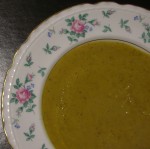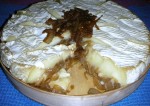If there is a complicated way to do something and an easy way, I will inevitably choose the former.
But I was recently reminded of the beauty in keeping things simple. This time of year, the week between Rosh Hashana and Yom Kippur, is a time of self-reflection — not a bad time to review this lesson that holds both in the kitchen and out.
Having only cooked for Rosh Hashana once before, I received a lot of help from my family in preparing to share the 2 days of holidays with over a dozen guests: we divided and conquered. I planned the overambitious menus (only parts of which ever came to fruition). My parents brought a case of wine up from Maryland. My dad and sister did most of the food shopping. My mom helped with much of the food prep, acting as sous chef in my kitchen.
Even with all those helping hands, I was nonetheless overjoyed to discover a cake that nearly bakes itself.
Not Derby Pie touts the base recipe as “The Easiest Cake Ever” and Rivka pictured it with ripe, juicy pears. I planned to add in some apples to the pears in honor of Rosh Hashana and to make it reminiscent of a gâteau pomme poire that I have been trying to recreate since I did a high school student exchange in the Loire valley followed by the Vendée in the northwest of France. However, given that my sister did the grocery shopping and doesn’t like pears, I ended up with just an apple cake. Not that this is just any apple cake.
The high egg content causes the cake to rise up as the heavier fruit sinks slightly. A light sprinkling of raw demerara sugar creates a crackly crunchy crust that caramelizes slightly at the edges and where the fruit juices pool.

Easy Apple Cake
Adapted from Not Derby Pie’s “Easiest Cake Ever” which is recommended for ripe, juicy fruits such as pears, stone fruits, or berries. Given that I was using apples that were not particularly juicy, I decided to first saute them in some margarine and sugar, giving them a slight juicy caramelization as I would for a tarte tatin.
2018 update: TL;DR – YOU CAN’T MESS THIS UP!
1) Based on questions and comments, you can skip the step of sautéing apples and instead macerate just 3 very thinly sliced apples (16-20 slices per apple) for a half-hour in 1-2 T sugar and a splash of lemon juice to soften them – the apples will bake up just fine, but the top doesn’t look as nice. Better yet, just mix all the apples in with the batter and don’t bother to arrange any on the top. A non-baker friend wrote: “No precooking of the apples, only own olive oil, don’t even own a baking pan of the right size and it STILL came out great. Also already 1/2 gone gotta go make another one.”
2) In addition, I made it with Cup4Cup GF flour and it worked like a dream.
3) This cake freezes well. First wrap tightly in plastic, then in heavy duty aluminum foil. If you want to reheat – make sure to remove the plastic from underneath the foil. Yes, you could just wrap in foil, but it doesn’t stay as fresh.
4) Check out the comments on this recipe on Food52 for a lot of different variations
Serves 8-10 and there will be no leftovers. This is probably great with ice cream, but this cake needs no accoutrement.
For apples:
4 apples – I used a variety (1 each of Gala, Fuji, Granny Smith, and Crispin)
lemon juice to prevent apples from browning as you cut
2 T margarine (or butter if you are making dairy)
1-2 T sugar (or to taste)
For cake batter:
1 C flour
3/4 C sugar
2 eggs
1/2 C canola oil
1 t baking powder
1 t vanilla
2-3 T demerara sugar (optional)
Preheat oven to 350º F. Grease and flour a 9-inch cake pan, springform or square pan. (If you want to plate this, use a springform; otherwise, just serve it out of the pan.)
Peel and core the apples, then cut into ~12 slices. Sprinkle with lemon juice (you don’t need much – maybe a tablespoon or so for 4 apples) while the others are being sliced to prevent browning.
Heat margarine in pan over low heat and add apples and 1-2 T white sugar. Stir for ~10-15 minutes until apples soften. Some of the liquid will soak into the apples, but if too much of it starts to evaporate, then turn the heat down.
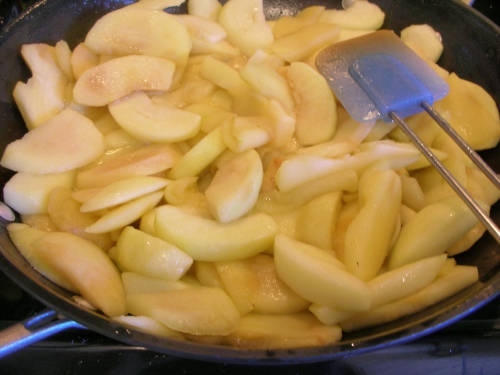
While the apples are on the stove top, mix together the remaining ingredients (except for the demerara sugar) — flour, sugar (the 3/4 C), eggs, oil, baking powder, and vanilla. No mixer is required – you can just mix everything by hand even though the batter is quite thick.
Add half the warm apples (juices and all) to the batter and mix. Then pour into the prepared pan and spread the batter evenly with a spatula. Arrange the remaining apple slices on the top of the batter as decoratively as possible (though even a mishmash will look nice).
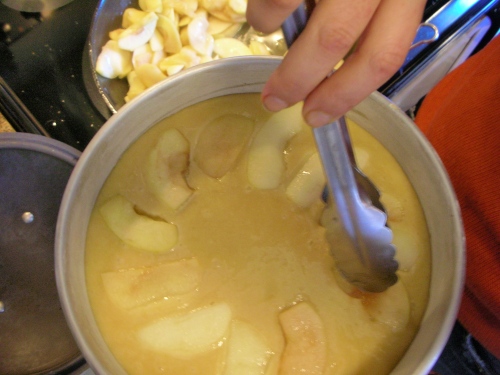
for the record – I only used tongs because we were having guests that I had never met … normally I’d just use my fingers!
Sprinkle the cake with demerara sugar if you’d like and bake for 1 hour.
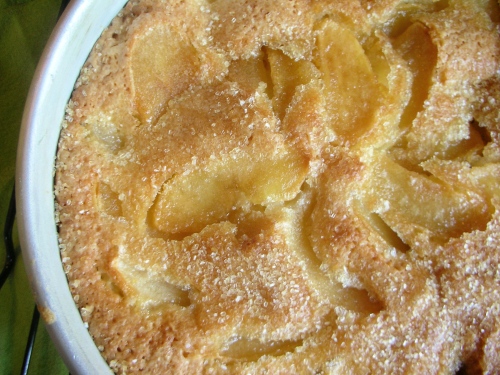
Let cool before attempting to remove from the pan. It can be a bit difficult to plate due to the stickiness of the fruit (I did a bit of clever patching that you can see close-up below).
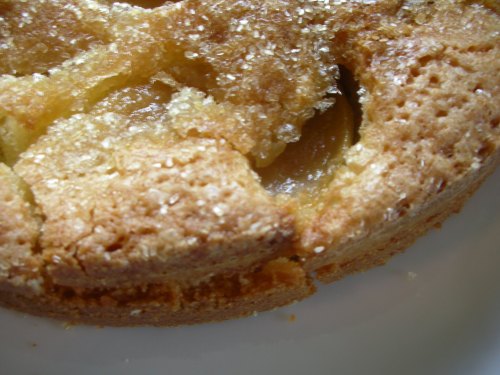
I was a bit overzealous in the number of apples that I asked my mom to peel, and we had so many left over that in 5 minutes flat, I whipped up a second batch of batter and made another cake.
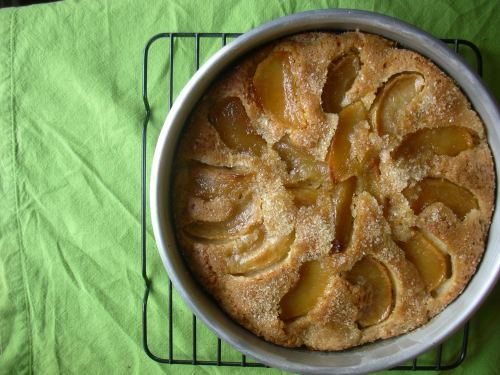
*** 2018 updated photo: apples macerated in sugar and lemon, not sautéed***












